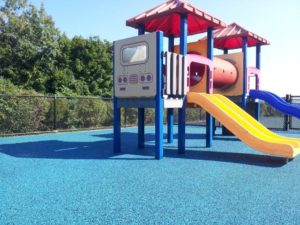Is Your Playground Safe? 8 Things Parents with Young Children Need to Know
Modern playgrounds don’t look like the playgrounds of old. The evolution of the playground is a good thing for children. Today, we know a whole lot more about making play areas safer for children. Many of the design changes you’ve likely seen in some community parks help prevent playground injuries.
Nonetheless, each year some 200,000 children go to hospital emergency rooms after a playground accident. And that’s where parents come in. Here are eight things to be mindful of when your kids are at the local playground.
1. Take note of your park’s fall protection surfacing.
Concrete, blacktop, packed earth, and grass: These surfaces don’t adequately cushion children’s falls, which is the leading cause of playground-related injuries. Falls cause more than 79 percent of all accidents. If your park has a hard surface, keep in closer proximity to your child.
Surfaces such as wood chips, sand, and pea gravel are not much better but FallZone Playground Safety Surfacing systems provide far better protection & do not move like loose infill products and have little to no maintenance.
2. Nix the drawstrings, jump ropes, and helmets while your kids are playing.
Hoodies may be cute, but drawstrings present a serious safety hazard for children. In fact, the U.S. Consumer Product Safety Commission does not recommend using drawstrings on children’s outerwear sizes 2T to 16 because of the potential strangulation hazard.
That warning is even more important at the park, where strings and jump ropes can catch on bolts, hooks, or corners. And if you bike to the park, have your child remove his helmet before he starts playing. The straps can be a hazard, and helmets can get caught in openings.
3. Mind the trip hazards.
Before you start playing, scan the ground and look for trip hazards. During an enthusiastic play session, children can easily trip on concrete footings on equipment, rocks, tree roots, sticks, and even on rubber tiles that may be loose or are buckling. Remove what you can, and have a conversation with your child about hazards you can’t remove. Make sure the playground area has the proper FallZone Safety Surfacing before you start playing.
4. Check for dangerous hardware, pinch points, and worn-out equipment.
Take a look at the equipment. Exposed bolts sticking out, S-hooks that can catch on clothes, and cracks in equipment all can cause injuries. Equipment such as see-saws can create pinch points for little fingers.
5. Watch your kids.
It sounds obvious, but it’s estimated that over 40 percent of all playground injuries are directly related to a lack of adult supervision. Young children are constantly testing their abilities and often don’t know the hazards around them. How high is too high? Check out this 1-minute video to help them about making smart choices while they explore.
6. Know what your child can do.
Two-year-olds and eight-year-olds are at very different stages of development. Help your child stay within her physical abilities. Playgrounds should have signage that tells you what ages the structures are designed for, but not all do.
According to the U.S. Consumer Product Safety Commission, the following equipment are not recommended for preschool-age children: fulcrum see-saws, log rolls, sliding poles, free-standing arch climbers, and chain-and-cable walks.
7. Look for hazardous openings.
Spaces in guardrails or between ladder rungs should be less than 3.5 inches or more than 9 inches. Why? Children can wiggle their bodies through, but find their heads get stuck. The openings in cargo nets, too, should either be too small to permit a child’s body to enter or large enough to allow a child’s head to pass through.
8. Check for guardrails on tall equipment.
The lack of guardrails or transition platforms were cited as the reason. Elevated surfaces should have guardrails or barriers to prevent accidental falls and making sure you have the right fall protection is key to preventing injuries.
For more information go to www.fallzonesafetysurfacing.com or contact us @ 1-888-808-1587
Contact Your FallZone Surfacing Specialist Today For More Information
"*" indicates required fields
